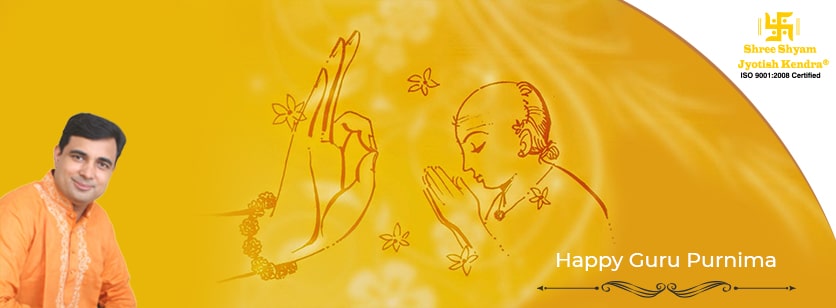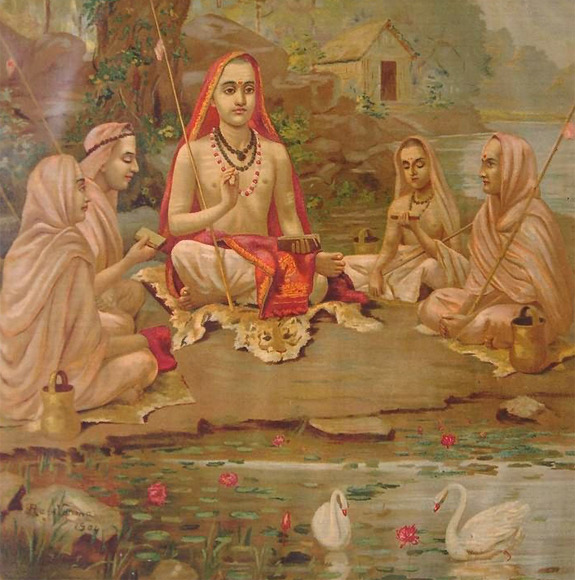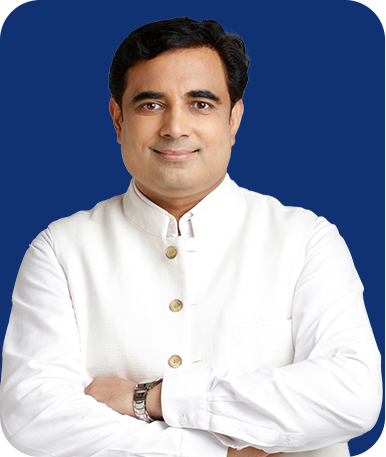
In the words of the famous Saint Kabir:
गुरु गोविंद दोऊँ खड़े, काके लागूं पांय।
बलिहारी गुरु आपने, गोविंद दियो बताय॥
The true meaning of this Doha is that when Kabir saw both his Guru and God (Govind) standing together, he wondered whose feet should he touch first. Understanding his dilemma, God himself pointed towards his guru and said, touch his feet first.
Such is the tradition of our culture, and every year, we celebrate Guru Purnima to pay our respects to our teacher. This year, Guru Purnima will be celebrated on 21 July 2024.
Celebrated in Hindus, Buddhism, and Jainism, Guru Purnima holds a significant position in the festivals of the land of India. It is considered an auspicious day to pay respects and gratitude to the academic and spiritual teachers in one’s life. But how did the festival start and what is its significance? What are the rituals of Guru Purnima? This blog details everything that you need to know about this great festival.
Definition of “Guru”
The word “Guru” comes from two Sanskrit words: “Gu” which means darkness or ignorance, and “Ru” which means dispeller or remover. So, a Guru is someone who dispels the darkness of ignorance and leads the way to enlightenment and knowledge. In both spiritual and academic life, a Guru is revered as a guide and teacher who helps individuals reach their full potential. This role is not limited to religious leaders but includes anyone who imparts wisdom and knowledge, helping to shape minds and spirits.
Historical Significance of Guru Purnima
Guru Purnima has its roots in ancient Vedic traditions, where gurus or teachers were revered as embodiments of knowledge and wisdom. This day is dedicated to acknowledging the contributions of these spiritual teachers and mentors who guide people on their journey toward enlightenment.

One of the earliest references to Guru Purnima is found in the ancient texts of the Vedas, where the role of the Guru is highlighted as paramount in the pursuit of knowledge and spiritual growth. The festival is also deeply connected to the great sage Vyasa, who is credited with compiling the Mahabharata, one of India’s most important and revered texts. Vyasa is also believed to have divided the Vedas into four parts – Rig, Yajur, Sama, and Atharva – to make them more accessible to the people. Due to these monumental contributions, this day is also known as Vyasa Purnima, in his honor.
Furthermore, in Buddhism, Guru Purnima is celebrated in remembrance of Gautama Buddha, who gave his first sermon on this day at Sarnath, Uttar Pradesh, after achieving enlightenment. This sermon is known as the “Dhammacakkappavattana Sutta” and marks the beginning of the Buddha’s teaching journey, highlighting the importance of the Guru’s role in spreading wisdom.
Jainism also observes Guru Purnima in honor of Lord Mahavira, the 24th Tirthankara, who made Indrabhuti Gautama his first disciple or guru on this day. This event is celebrated to acknowledge the transfer of spiritual knowledge and wisdom from the enlightened one to his disciple.
Thus, Guru Purnima holds a profound historical significance across various religious traditions, emphasizing the timeless and universal respect for teachers and mentors who have shaped the spiritual and intellectual fabric of society.
Spiritual Significance of Guru Purnima
The spiritual significance of Guru Purnima lies in the profound respect and reverence for the Guru, who is considered the guiding light on the journey of life. A Guru is believed to dispel the darkness of ignorance and lead disciples toward enlightenment and knowledge. This day is an opportunity for followers to express their gratitude and acknowledge the vital role that their Gurus play in their spiritual and personal growth.
On Guru Purnima, the full moon is believed to have a special spiritual energy that enhances emotions, sensitivity, and the ability to connect with higher consciousness. The full moon’s radiance is thought to amplify the blessings and teachings of the Gurus, making it an ideal time for meditation, self-reflection, and spiritual practices.
Many people use this day to reflect on their spiritual journey, renew their commitments to their spiritual practices, and seek guidance and blessings from their Gurus. It’s a time for deep introspection, where disciples can evaluate their progress on the spiritual path and set new intentions for growth and development.
The celebration of Guru Purnima encourages followers to look within, seek inner peace, and strive for higher wisdom. It is a reminder that the Guru’s guidance is invaluable in navigating the complexities of life and achieving a state of balance and harmony. By honoring the Guru, individuals reaffirm their dedication to their spiritual path and express their heartfelt gratitude for the wisdom and enlightenment imparted by their teachers.
Importance of the Full Moon in Ayurveda and Relation to Guru Purnima
In Ayurveda, the moon holds a significant place due to its profound influence on the mind (Manas) and emotions. The connection between the moon and our mental and emotional well-being is deeply rooted in Ayurvedic philosophy. According to Ayurveda, the moon acts as a bridge between the soul and the body, influencing our thoughts, emotions, and perceptions.
The moon’s cooling and soothing qualities are believed to promote emotional stability and tranquility, helping to balance the mind. Since our bodies are composed of 60-70% water, the moon’s gravitational pull is thought to affect both our physical and mental states. This influence is especially heightened during the full moon, making it a powerful time for spiritual practices and emotional clarity.
During Guru Purnima, celebrated on the first full moon of the month of Ashadh, this connection is believed to be at its peak. The full moon’s energy enhances gratitude and spiritual connection, making it an ideal time for honoring Gurus and seeking their blessings. The phases of the moon have distinct impacts:
- Waxing Phase: From the new moon to the full moon, the increasing lunar energy is believed to enhance mental clarity, creativity, and positivity. It’s a great time for setting intentions, starting new projects, and focusing on personal growth.
- Waning Phase: From the full moon to the new moon, this period is ideal for release and introspection. It’s a time to let go of negativity and embrace healing and renewal.
On Guru Purnima, the full moon’s peak energy is especially powerful for meditation and gaining deep emotional insights. This makes it an opportune moment for individuals to engage in spiritual practices, reflect on their journey, and connect more deeply with their inner selves and their Gurus.
The emphasis on the moon in Ayurveda underscores the holistic approach to well-being, integrating the natural rhythms of the cosmos with our mental and emotional health. By aligning with the moon’s phases, individuals can achieve greater harmony and balance in their lives, enhancing their spiritual growth and overall well-being.
Ayurvedic Practices for Celebrating Guru Purnima
Ayurveda offers several practices to honor the spiritual significance of Guru Purnima, aligning with the heightened energy of the full moon. These practices help individuals connect deeply with their Gurus, enhance their spiritual insights, and promote overall well-being.
1. Meditation and Reflection:
- Meditating on the full moon night of Guru Purnima is especially beneficial. The moon’s natural glow enhances the meditative experience, helping to calm and focus the restless mind, thereby fostering inner peace and balance.
- Spend time reflecting on your spiritual journey, acknowledging the guidance received from your Guru, and setting intentions for future growth.
2. Diet:
- The food we eat is metabolized into two key elements: mind energy and prana (life force). This mind energy is centered in the pineal gland, which releases crucial hormones.
- At night, the moon exerts its influence on this gland, governing our activities until we awaken. Eating a light, sattvic (pure) diet on Guru Purnima can enhance mental clarity and spiritual receptivity.
3. Abhyanga (Self-Massage):
- Perform a self-massage using warm, soothing oils like sesame or coconut. This practice calms the nervous system, promotes relaxation, and improves mental clarity.
- Abhyanga helps in releasing physical and mental tension, making it easier to focus on spiritual practices.
4. Gratitude Rituals:
- Express gratitude to your Gurus by performing rituals such as lighting candles, offering flowers, or reciting prayers. Gratitude can elevate your emotional state and strengthen your spiritual connection.
- Write a letter of gratitude to your Guru, reflecting on the teachings and guidance you have received.
5. Moon Bathing:
- Moon bathing, or sitting in the moonlight, enhances Vitamin D availability, increases vitality (ojas), balances pitta dosha, and reduces inflammation.
- Embrace this serene practice to harness the moon’s calming energies for physical and mental harmony. During Guru Purnima, moon bathing can deepen your spiritual connection and provide a sense of tranquility.
These Ayurvedic practices help individuals honor their Gurus, align with the moon’s spiritual significance, and promote mental and emotional balance. Engaging in these rituals during Guru Purnima can reduce stress and anxiety, enhance spiritual insights, and reinforce the importance of maintaining a calm and focused mind for overall health and well-being.
Guru Purnima is marked by various rituals and celebrations that reflect the deep respect and reverence for Gurus. These practices are designed to honor the Guru and seek their blessings, fostering a sense of spiritual connection and gratitude.
1. Special Prayers and Pujas:
- Temples and ashrams across India organize special prayers and pujas dedicated to Gurus. These ceremonies involve chanting mantras, reciting sacred texts, and offering flowers and fruits to the Guru.
- Devotees participate in these rituals to express their devotion and gratitude, seeking spiritual blessings and guidance.
2. Offerings to Gurus:
- Disciples present gifts and offerings to their Gurus as a token of respect. These offerings can range from simple items like fruits and flowers to more elaborate gifts.
- The act of giving symbolizes the disciple’s devotion and acknowledgment of the Guru’s role in their spiritual journey.
3. Meditation and Spiritual Discussions:
- Guru Purnima is an ideal time for meditation and spiritual discussions. Many ashrams and spiritual centers conduct group meditation sessions and satsangs (spiritual discourses) led by the Guru.
- These sessions provide an opportunity for disciples to deepen their understanding of spiritual teachings and reflect on their personal growth.
4. Charitable Activities:
- Engaging in acts of charity and kindness is a common practice during Guru Purnima. Followers perform charitable deeds such as feeding the poor, donating to temples, and helping those in need.
- These acts of generosity are seen as a way to honor the Guru’s teachings of compassion and selflessness.
5. Fasting and Purification:
- Some devotees observe fasting on Guru Purnima as a form of spiritual purification. Fasting is believed to cleanse the body and mind, making it easier to focus on spiritual practices.
- The fast is typically broken after offering prayers and seeking the Guru’s blessings.
6. Community Gatherings:
- Guru Purnima brings together communities of disciples who gather to celebrate their Gurus. These gatherings often include cultural programs, devotional singing, and shared meals.
- The sense of community and shared devotion enhances the spiritual atmosphere, creating a collective expression of gratitude and reverence.
These rituals and celebrations are integral to the observance of Guru Purnima, providing a structured way for disciples to honor their Gurus and deepen their spiritual connection. By participating in these practices, individuals reaffirm their commitment to their spiritual path and express their heartfelt gratitude for the wisdom and guidance received from their teachers.
Conclusion
Guru Purnima is a profound and spiritually enriching festival that transcends religious and cultural boundaries. It is a day dedicated to honoring the Gurus who guide us through the journey of life, dispelling the darkness of ignorance and leading us towards enlightenment and knowledge. Celebrated with deep reverence and gratitude, Guru Purnima offers an opportunity for individuals to reflect on their spiritual paths, express their appreciation for their teachers, and engage in practices that enhance their mental and emotional well-being.
From its roots in ancient Vedic traditions to its observance in Hinduism, Buddhism, and Jainism, Guru Purnima holds a universal appeal that unites diverse communities in a shared expression of respect for educators and spiritual mentors. The rituals and celebrations, whether through special prayers, meditation, or acts of charity, highlight the enduring significance of the Guru-disciple relationship.
Drawing insights from various sources, we understand that Guru Purnima is not just about honoring a person, but about embracing the teachings and wisdom that help us grow spiritually and intellectually. It reminds us of the vital role that Gurus play in our lives and encourages us to cultivate a sense of gratitude, reflection, and spiritual growth.
As we celebrate Guru Purnima, let us acknowledge the invaluable contributions of our Gurus, commit to our spiritual journeys, and strive to embody the principles of wisdom, compassion, and enlightenment that they impart.
For personalized guidance and to deepen your spiritual understanding, consider seeking insights from renowned astrologer and spiritual guide Pt. Pawan Kaushik. His expertise can help you navigate life’s challenges and enhance your spiritual journey. Visit his website to learn more and book a consultation.
 +91 9990176000
+91 9990176000 +91 9999097600
+91 9999097600
 CALENDAR 2025
CALENDAR 2025





